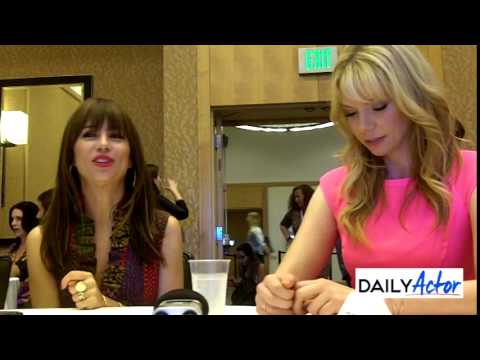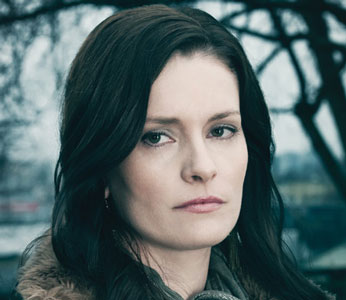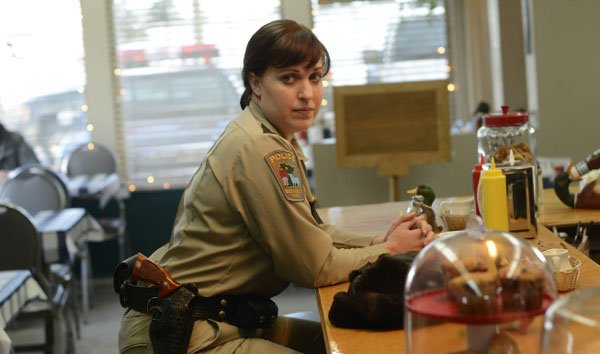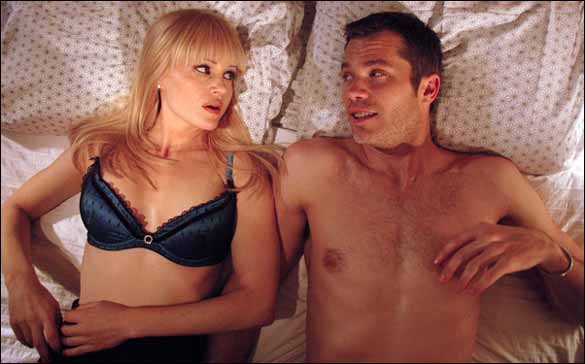Director Andrew Cumming’s ‘Out of Darkness’ is one heck of a feature debut. Starring Safia Oakley-Green (“Sherwood,” “The Burning Girls”) and Kit Young (“Shadow and Bone,” The School for Good and Evil), the film follows a small group of early humans desperate to find a new home to call their own. After finding shelter, the group soon start to realize that they aren’t alone.
The film is tense, dark and terrific and what makes it even more authentic are the locations and new language that was created for the film. While it was difficult to learn at first, Young said as they went on in the shoot, “it just kind of became more and more second nature.”
In this interview, Cumming, Oakley-Green and Young, discuss the impact of filming on location in Scotland, the challenges of learning the new language and the unique audition process. This interview has been edited for length and clarity.
You filmed this in Scotland, and it just makes it feel so much more authentic. How did you decide to film it there?
Andrew Cumming: I’m Scottish. I toured that area a lot, either as a tourist or in my professional capacity as a filmmaker. I knew it had the infrastructure to get us to places that gave the impression that you were in desolate, expansive landscapes with mythic, ancient features that just felt vast and dangerous. And that gives the film attention.
I’ve filmed on location before and it helps a lot to get you where you need to be, acting-wise. How much did it help you two?
Kit Young: We were also shooting in perhaps the most extreme weather conditions I’ve seen, let alone worked in. We were very fortunate because it was kind of how Andrew and the crew scheduled it, but there was beach week and there was like tundra week and then we went into the woods. When we got up into the mountains and stuff, you don’t have to pretend like, “Oh, this is 45,000 BC.” You just mentally edit out the telephone pole that’s sort of in the distance.
But we were really out in a place that is it’s not wildly populated by man. It wasn’t that there was a skyscraper around the corner, like we really were out there. Because when you read a script, you kind of go, “Oh, I wonder what that set will look like and maybe it’s been built. Maybe we’re going to go transform some found space into something really cool.” It was just there. Everything was so there and visceral for us. The only thing we had to do was really, as you always do, is like, edit out the crew who are in Parker jackets and beanies because other than that, it could be 45,000 BC. We’re a group of people in furs speaking made up language literally in those locations. So, it really did make sense.
Safia Oakley-Green: And it really helped with the performances, having that beach week because on beach week we were like, “Yeah, we can’t wait!”
Kit Young: It sounds so spring break, but it’s not.
Safia Oakley-Green: And then we were like, “We can’t wait to get to the caves.” And then we were in the forest, and we were like, “We cannot wait to get out of this forest.” So it really helped because we did really feel those things being outside all day, every day for hours for six weeks.
You can see it in our faces. By the end of the film, our faces are swollen and our skin feels thick, and everything is just heavier. We had spent so long tensing our muscles from the cold that we’ve become rigid and all of that physicality and actual kind of the brutality of nature fed into our performance so massively.
The landscape is the seventh character in the film without a doubt. I’d say the most important character in the film is the landscape. It’s so incredible.
Andrew Cumming: The thing that cinema doesn’t do as well is smells, like towards the end, their costumes they really, really stank.
Kit Young: There was some decomposition happening.
Safia Oakley-Green: They stank at the beginning.
Kit Young: The one thing I will say is that often what happens is you go off and shoot something, especially if you’re away from home, and you are kind of in a bubble. Even if it’s not a COVID bubble, you’re in a bubble and you’re off doing that thing. There’s always a little bit of a slightly tricky period when you come back, you’re kind of putting your reality back. Imagine all of us coming back to cities in various countries around the globe and feeling like we speak caveman walking into Tesco. It was so privileged to experience those places in such a kind of vivid way that when we came back, I didn’t know what to do with myself for a long time. It was very bizarre.
Safia Oakley-Green: Me too. It was weird. It was a really weird one to adjust back from. We lived in it. We really lived in it.
Kit Young: Also, there was no catering truck, there was no dining table. It was hot boxes of foods, and it was just, “Here you go, here you go, here’s your order.” And you would just find a rock or a little grassy stump and you would curl up.
Safia Oakley-Green: I remember being back at home, my mum was like, take your… Like, I’d put my… I’d have my knees up on the chair, like, whilst I was eating. She’d be like, take your feet off the chair. We’re at the dinner table. It took me so long to, like, eat like a human again. Like, not with my hands.
I want to ask about the language that you spoke in the film. What was the process in learning that? Because, I sometimes have a hard time remembering my lines in English, so I can’t imagine trying to learn a new made-up language.
Kit Young: Oh, no, we definitely forgot stuff all the time. I remember doing a line and going, “No, no, that was yesterday’s line. That was yesterday. Sounds similar, but not quite.” Like with any language, or with any acting, you do get the slight advantage on screen of paying attention to the bit you have to do immediately, and then doing that, unlearning it, letting it go, looking at the next thing. But I think I can speak for all of us involved that as we went on, it just kind of became more and more second nature.
Whereas, at the beginning, you’re trying to get your mouth around it and feeling like when you write with one hand, suddenly trying to write with the other, it feels wrong and feels like you’re a baby learning from scratch. And then suddenly, you’re like, “Oh, okay, well, if we’re doing this together, we kind of we’re boosting one of each other up.”
And then it kind of became quite straightforward, in a way, until Andrew would come in with a note. And then I’d go, “Well, actually, Andrew, it’s pronounced like this.” And he’s like, “Yeah, but the scenes more important than how you think it is.” And I was like, “Okay, fine.”
These damn directors, man. They always gotta be sticklers.
Kit Young: Yeah, he’s trying to make a movie. I’m trying to be authentic. [laughter]
What were your auditions like? Did you audition in English? or did you have to learn any of the made-up language?
Safia Oakley-Green: The first one was English. I think the second one had two scenes in English, one scene in the language or something like that. I don’t know whether there was one that was just in the language. But then by the time we were in the room, it was all in the language.
And also in the room, there was an obstacle course. So, we walked into the room and there was a table, there was a suitcase, there was a broom.
Andrew Cumming: There was a sphere.
Safia Oakley-Green: There was a sphere and there were some caves, suitcases. And Andrew was like, “You have to go under and over, around, you have to look like you’re hunting a hare.” It was a really cool audition.
But I went into it thinking, “Oh my God, I’m gonna have to do this language. Those guys are obviously gonna know it word for word.” And then to go in there and be kind of completely thrown off and get all of your adrenaline and energy out for the first 20 minutes doing these hunts and smashing things and breaking things. And by the time we got to the dialogue, I was tired.
Kit Young: Yeah, I think the first the first round you sent in a tape, and it was like, just a script in English. And it was also one of the only scripts, probably the first script I’d read beginning to end without putting it down.
And then they rudely sprung up on me that there was another language after I got invested already. I was like, “Oh, no, I’ve got to learn this whole other thing.” But then that in itself was a lot of fun.
And then when it came to the obstacle course, I mean, it’s very similar to green screen work or blue screens where you’re suddenly like, “The monsters over there. No, it’s over there. The second monster’s over there.” And you kind of like surrender yourself to wherever you’re being led. And it really didn’t matter whether you were doing it in a room with a suitcase and a sphere, or whether it was on location.
The only fake bit or the bizarre bit is how you’re communicating. So, it’s just one other element to make your imagination leap. And I think it takes a little bit of finessing because you’re so used to communicating in one way. I think even behind the camera, nobody was speaking the language, but they were all getting it. They were all understanding what was going on.
Andrew, when casting the film, what was it about these two that made them stand out and made you know that they were the right ones? I mean, obviously you made the right choice because they were fantastic.
Andrew Cumming: I remember both of their tapes vividly because they made me lean in to my screen. Because you’re watching tape, tape, tape, tape, tape. And there were other fine actors on those tapes, but they were able to transmit. Like, Kit had very deeply thought about the language and how he was going to deliver it and had obviously done a lot of hard work just on that tape. So, on commitment alone, I was like, ‘I want to see this guy in the room.’ But also, he was really investing so much emotion into this.
And again, ‘I thought if he does half of that in the room, he’s got the part because it’s a hard thing to regurgitate over and over again.’ But if you’ve got it there to start with, it makes my job as a director much easier to try and eek that out when we’re on the floor.
And with Safia, I mean Kit had done a bit. You’d done Shadow and Bone by that point, right? So, Kit had done long form television. Safia had done two short films and was this complete unknown entity that Heather Basten, our fantastic casting director, unearthed her from somewhere.
I was just watching this kid that just had… I could read her thoughts. I could see the thought process. And obviously, the look and everything else was what [writer Ruth Greenberg] and I had always imagined. But in a film where there isn’t a lot of dialogue, you just need to know that somebody has got that thought process. And then you get them in the room, you work with them physically, you work with them over the lines. Can they take my direction the way I direct? And then the decision comes pretty easy.
And then it’s wonderful afterwards where you start to work with them and you realize, “Oh, you guys are not only talented and have imaginations, you’re also really diligent. And you do your homework and you have interesting questions and you look out for each other and you look out for the rest of the cast.” So, big shout out to Heather Basten because she put these guys in front of me and without her it might have went a different way.




